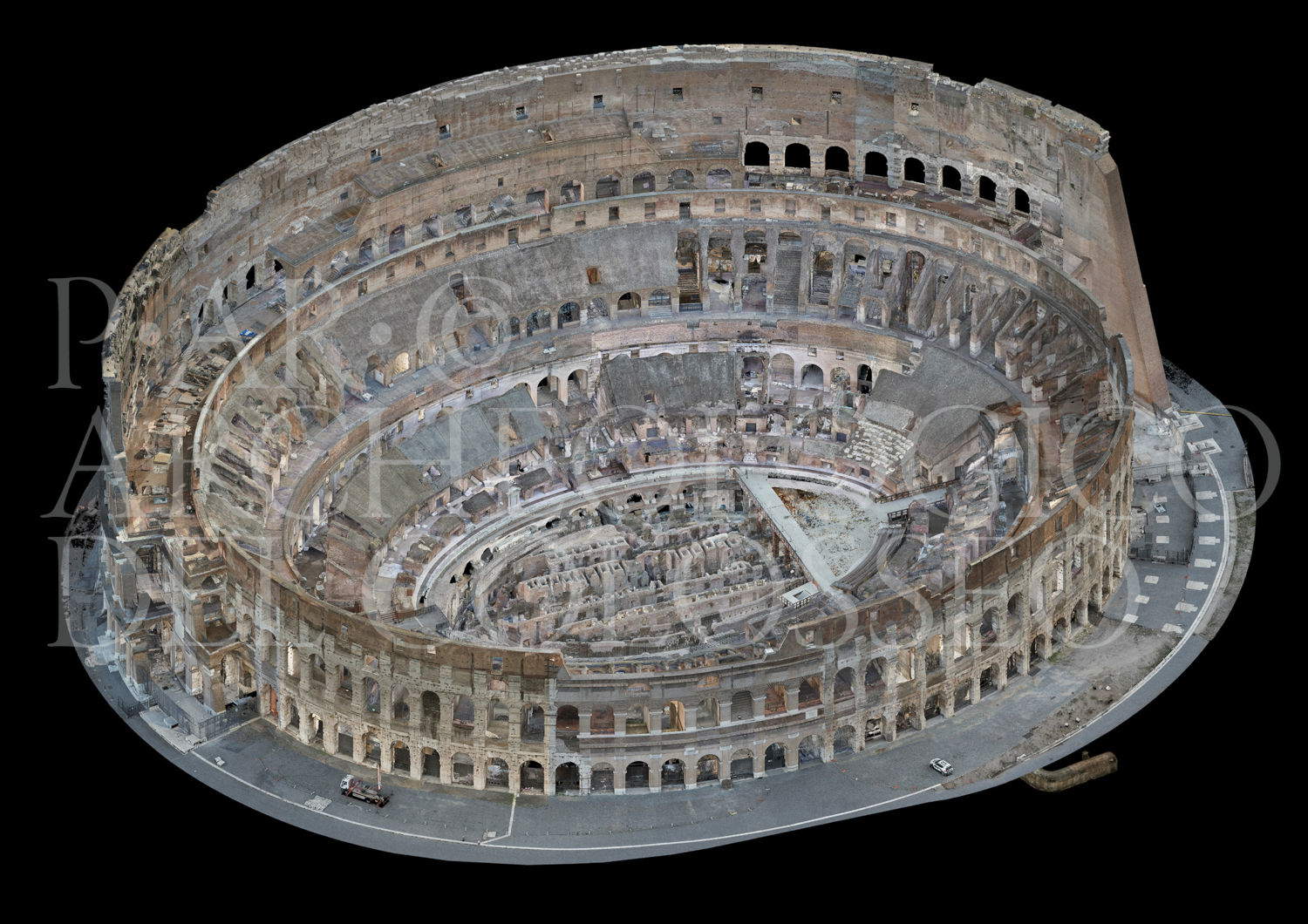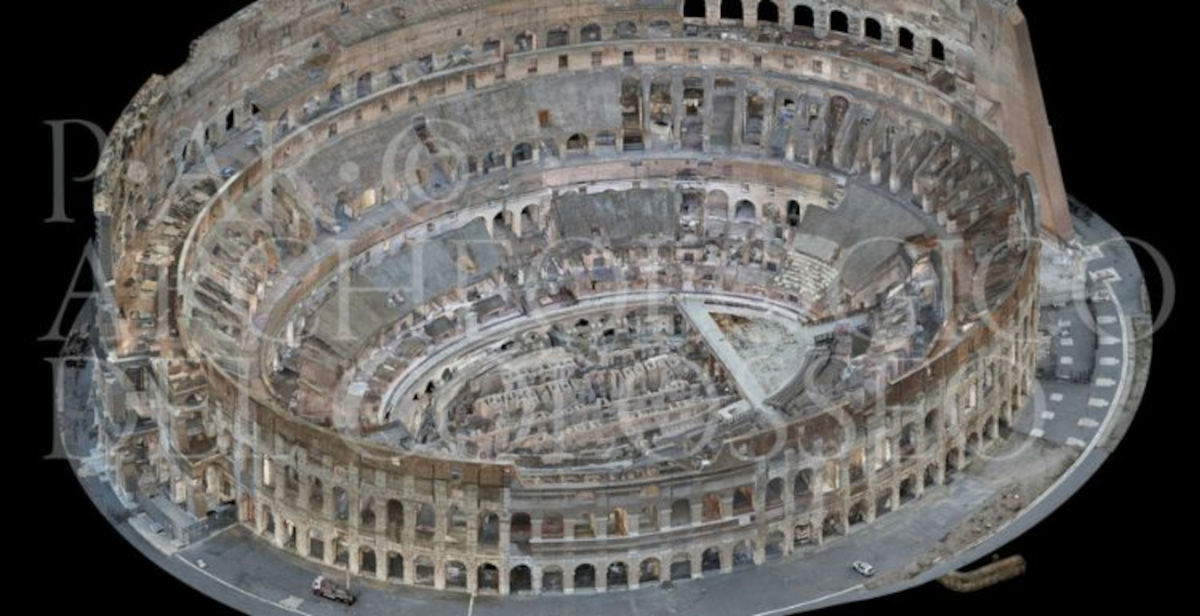For the first time in its history, the Colosseum has been fully digitized thanks to an integrated three-dimensional survey and Heritage Building Information Modelling (HBIM) project. The intervention, promoted by the Colosseum Archaeological Park directed by Alfonsina Russo, has generated the first complete geometric-morphological database of the amphitheater, laying the foundations for a new phase in the management, conservation and enhancement of the monument. The project was carried out over two years, under the scientific responsibility of Dr. Federica Rinaldi and the direction of Architect Barbara Nazzaro. The operations were carried out by a grouping of companies led by Consorzio Futuro in Ricerca CFR of Ferrara, joined by GEOGRA’ Srl of Sermide, ETS Srl and JANUS Srl of Rome. The different skills brought to bear allowed each phase of the work, from data collection in the field to its digital processing, to be addressed in an integrated manner.
The result of the project will be presented publicly on two separate occasions. The first will take place on May 7 and 8, during the conference organized at the Curia Iulia in the Roman Forum, promoted by the Department for the Enhancement of Cultural Heritage together with the General Directorate for Museums, the Colosseum Archaeological Park and the National Museums of Perugia. The second presentation will take place on May 14 at the Restoration Exhibition in Ferrara, where a booth entirely dedicated to three-dimensional modeling of the Colosseum will be set up and a panel will be organized to explain in detail the technical and operational features of the project.
“Having an HBIM model of the Colosseum,” says Alfonsina Russo, Director of the Colosseum Archaeological Park, “means preserving and analyzing the past with the tools of the future: finally it will be possible an integrated and multidisciplinary management of the monument, providing structural analysis, conservation monitoring and planning of interventions through an interoperable information system that can be updated over time. The challenge for the future, thanks to the presence of an innovative tool that allows for an integration of archaeological, geometric and material data in a single digital environment, supporting more informed decisions and more sustainable interventions, will be to develop and implement specialized training and maintain the necessary coordination with public research institutions and private sector operators, so that the potential of digital translates into real value for the preservation of collective memory.”

The panel will describe the stages of the integrated survey that combined several technologies: traditional topography, laser scanning, ground and drone photogrammetry. These techniques produced a high-definition survey, accompanied by thematized architectural documentation. The digital elaborations were oriented to various application areas: restoration, through the segmentation of the survey according to materials, construction techniques and conditions of degradation; structural analysis and assessment of instability; and archaeological documentation, including wall relationships, stratigraphic units and erratic elements. At the heart of the project is the HBIM model, which enables centralized management of information regarding each individual element of the monument. The system integrates data on geometry, materials, construction techniques, state of preservation, masonry stratigraphy and crack framework. It is a dynamic and updatable archive, useful for any study or intervention project, from ordinary maintenance to extraordinary conservation and public use.
In detail, the digitization produced an unprecedented amount of data. Eighty-four point clouds were generated by laser scanner and 86 by photomodeling. To these were added 90 themed clouds. For the laser scanner part alone, 2,434 stations divided between exterior, cavea, hypogea and interior wedges were carried out, totaling more than 108 billion points acquired. Added to these are more than 208,530 photographic images, of which more than 15,000 were taken by drones. The 2D drawings include 8,704 CAD files and 2,619 tables, divided into architectural surveys, maps of materials, construction techniques, states of preservation, and wall stratigraphies. The work also produced ten HBIM models, consisting of 27,664 digital objects with 85 specific parameters implemented and 6,361 associated links. The 11 structured datasets within the models allow for advanced operational consultation and management. All data are hosted in a dedicated workstation at the Colosseum Archaeological Park, accessible via VPN network with personal credentials. The system allows the survey to be updated and shared through an ACDat platform, ensuring continuity in the monitoring and management of the monument’s life cycle.
The 3D database thus becomes a fundamental resource for planning, controlling and documenting any future intervention, and is an indispensable tool for research and conservation. The Colosseum becomes an international case study for the application of digital technologies to the protection of archaeological heritage. The HBIM model, in fact, allows multidisciplinary integration between archaeology, architecture, engineering and conservation, facilitating more conscious and sustainable operational choices. The Colosseum thus becomes a state-of-the-art laboratory, capable of combining archaeological tradition and digital innovation. The goal is to understand and make accessible, through data, a heritage that is a foundational part of the collective cultural and historical identity. All 3D survey data are stored in a dedicated workstation at the Colosseum Archaeological Park, connected to a VPN network. Through specific software, the sharing environment (ACDat) can be accessed to consult and update the HBIM data.
 |
| The Colosseum in 3D: completed the first integrated digital survey of the monument |
Warning: the translation into English of the original Italian article was created using automatic tools. We undertake to review all articles, but we do not guarantee the total absence of inaccuracies in the translation due to the program. You can find the original by clicking on the ITA button. If you find any mistake,please contact us.